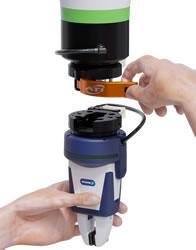AUVSI's Unmanned Systems Program Review 2013
Sequestration, Doing More With Less Both Keys on Ground Day
The first day of AUVSI's Unmanned Systems Program Review 2013, themed Ground Day, focused on capability consolidation and finances, as the threat of sequestration threatens many programs.
"If you're expecting really positive news today, I just cannot give it to you, but I can provide the current state of play," said keynote speaker Maj. Gen. Robert M. Dyess Jr, director of the Force Development Directorate for G8 Force Development.
The Army's plan to weather the financial storm includes divesting 2,469 robots to be repurposed for other agencies, though Dyess said no specific organization has been defined. He said the robots currently acquired by the Army will be "reset," so they can be upgraded for soldier needs.
The continuing budget resolution "ties our hands," explained Dyess. "It keeps us as a 2012 funding level. … We can't do any new starts, and we have limited ability to reprogram money."
Dyess said there will be increased focus on commonality and adding to what vehicles the Army already has through things like robotic appliqu© kits.
The Navy's Byron Brezina also discussed cost-savings measures with the open-architecture Advanced EOD Robotic System project. The Navy has currently completed the first increment of the project, which rolled out a small ground vehicle. Increments two and three are due to occur later this year and will focus on a medium-sized and a large UGV.
"The lessons learned from this history really got a lot of attention in the studies that went into AEORDRs, and the consensus was … that we really need a family of systems, starting from the ground up," he said.
The open-architecture approach increases competition, he said, and cuts down on the increased support and logistics costs associated with a hodgepodge of robots not housed in one family.
"If we had to do it all over again, we'd be doing what we're doing now."
Rep. Mo Brooks, congressman for northern Alabama, discussed the dire situation of sequestration, which is due to hit 1 March.
"Right now, we're at an impasse," he said, describing a scenario where members of his Republican party don't want to see massive cuts to the Department of Defense.
"As the American public better understands the adverse affect of sequestration that will create the pressure to force one side or the other to give in. I don't know how that will evolve.
"We're in a hell of a mess," he said. "We've built up about a $16.5 trillion deficit. … Quite frankly, I don't see any relief in sight."
Speaking for the commercial community was Polaris' Patrick Weldon, who described the differences between the autonomy community and original equipment manufacturers.
"Both autonomy companies and vehicle manufactures are very, very different," he said. "Autonomy providers like to think the vehicle is nothing more than an taxi. … The rider is nothing more than a passenger," whereas Polaris is foremost a commercial power sports company that is driven by the purchasing customer, he explained.
Weldon outlined a current gap in autonomy, where there are currently a lot of teleoperated robots and also a lot of very sophisticated platforms, like the Google car, but there are not many control-optional platforms that bridge that gap.
Though Weldon said that Polaris will never outright make a fully autonomous system, some of the growth areas he outlined for Polaris are shared with robotics manufacturers, like agriculture, mining and the military.
Weldon predicted a future consolidation between autonomy companies, many of which have approached him with concepts for semiautonomous platforms, he said.
"I know that's not popular to say, but I get a call from a different autonomy firm every few weeks now. … At some point I say, where is this going? What do you want to be when you grow up? And they don't have the answer."
Robin Murphy, a professor at Texas A&M and a pioneer in search-and-rescue robotics, has been studying the role of autonomy for the Department of Defense. She said the main benefit of autonomy remains augmenting the human, not replacing him.
"It's not so much replacing people, but giving new capabilities, faster, better more capable than we do now."
She said often, programs get caught up in defining levels of autonomy instead of working to support specific functions. Also, the autonomy community will need a new set of test and evaluation requirements, since the current standards outside of the community aren't a good fit.
"With autonomy, you cannot enumerate all the possible conditions that will happen," she said. "… That's a real change in how we do test and evaluation."
Featured Product

ATI Industrial Automation - Manual Tool Changers
Simpler, stronger, and more precise. ATI Industrial Automation has developed a series of Manual Tool Changers that provides a cost-effective solution for quickly changing tools by hand. They feature a unique design that combines high strength, excellent repeatability, and a patent-pending screw-cam locking mechanism with multiple fail-safe features, which resists vibration and prevents loosening. These robust and compact Manual Tool Changers can handle payloads up to 80 pounds (36 kg) and pass pneumatics and electrical signals.
